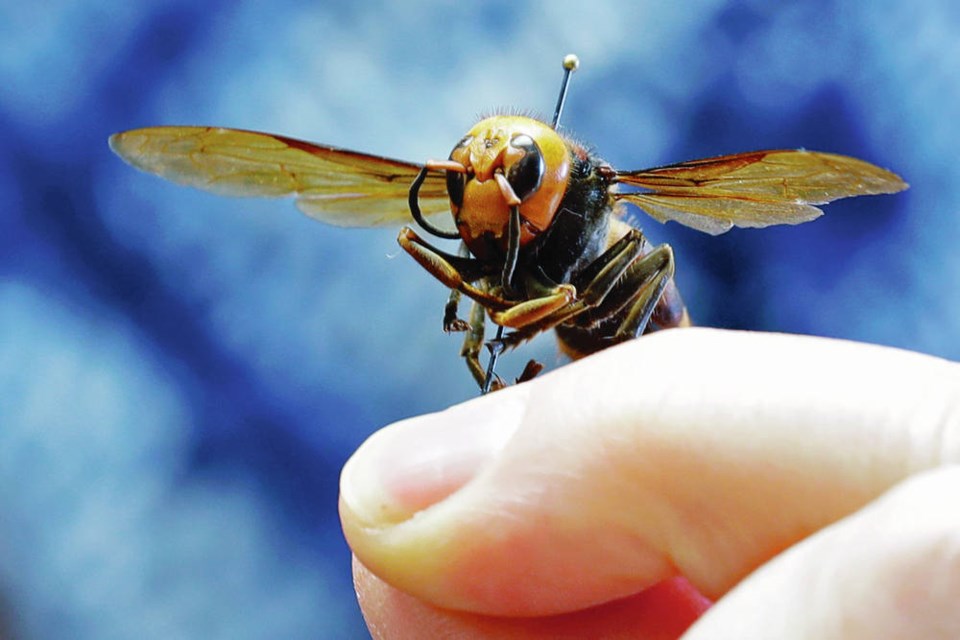Officials on both sides of the border are stepping up efforts to locate and destroy the Asian giant hornet, saying the nasty invasive species poses a serious threat to public health and honeybee populations valuable in pollinating agricultural crops.
Scientist say the so-called “murder hornets” are protein eaters and also prey on insect populations that create ecological balances.
British Columbia and Washington state officials say both jurisdictions will set more traps and initiate tracking technologies to trace the hornets to nests, and will rely on “citizen scientists” to be their eyes and ears over vast areas of Vancouver Island, the Fraser Valley and northern Washington state along the border.
“It is a serious threat, and a formidable task,” said Paul van Westendorp of British Columbia’s Ministry of Agriculture, who joined Canadian and U.S. beekeepers, scientists and agricultural representatives on a conference call Wednesday.
“There is a public health and exposure issue where these hornets have a strong defensive impulse when their nests are disturbed,” said van Westendorp.
He noted the first nest located in Canada was in a Nanaimo park in 2019, just over a metre from a public pathway, and the beekeepers who destroyed the site suffered multiple painful venomous bites.
Such nests pose serious threats to children and pets as well as wildlife and livestock, he said.
Washington officials said at least a dozen honeybee colonies were wiped out last year by the hornets — the bees decapitated and eaten.
“And there is the ecological pressure,” said Westendorp.”They go after all kinds of insects that play a role in looking after other populations.”
B.C. officials said there were no sightings of the Asian giant hornet in the Nanaimo area or in the Cowichan Valley last year, but will continue to monitor the areas. If there are no confirmed sights this year, van Westendorp said, the Island could be declared safe — although new infestations could pop up.
The hornets are unusually large — about five centimetres long with a seven-centimetre wingspan — and normally nest in the ground, but last year U.S. officials found and captured or killed a nest of 500 hornets, including 200 “virgin queens” in a tree. Some of the capsules that contain the queens were empty, spurring concerns they had already left to develop new hives.
Scientists said the hornets could start emerging with new nests as the weather warms.
Six giant hornets were found in the Fraser Valley last year, but no nests. The province will focus on that region this year with dozens of traps, mainly along the U.S. border.
All specimens collected last year in B.C. were from the citizens’ traps — not ministry traps — which van Westendorp said highlights the importance of “citizen scientists.”
He said people can use two-litre soda bottles to trap the hornets and use bait such as orange juice, rice wine or by mixing a cup of water and a cup of brown sugar.
Scientists in the United States said they have financial support from the federal government and “the best minds” behind the hornet’s eradication.
Anna Childers, bee researcher with the Agricultural Research Service in the U.S. Department of Agriculture, said they are examining specimens to determine the origin of the hornets.
Finding where they came from will help determine how to check shipments from Asia where queens are often stowaways and emerge to start new colonies.
Hornets collected from the nest in Nanaimo, for example, were comparable to samples collected in Japan. The Washington state hornets were from Korea.
But specifics can be difficult to determine, said Childers. The Asian giant hornet is a valuable commodity in Asia, where their nests are hunted and the hornets are sold as a dining delicacy. “[Nests and hornets are] moved around and that skews the natural dynamics and populations.”
Van Westendorp said the province has sent alerts to the federal government for increased scrutiny at international ports.
He noted the very first Asian giant hornet collected was in May 2019 at the Port of Vancouver, a few months before the discovery of the Nanaimo nest.
Sven Spichiger of the Washington Department of Agriculture, said the state will continue using VHF tracking tags on any captured hornets. It worked last year in finding the massive tree nest near Blaine, Washington,.
This year they will use a tough Kevlar thread to attach the tiny transmitters. “It was pretty frustrating at one point when we watched a hornet chew through the dental floss we used,” he said.
Westendorp said Canada will also consider transmitter tagging. “First we have to catch one of these characters to tag,” he said. “We have been growing frustrated at not being able to get our hands on one. The ones we did were dead.”
Van Westendorp considers the war on the hornet a success so far, “but time will tell.”
British Columbians who think they may have seen an Asian giant hornet can report it to the Invasive Species Council of B.C. website (bcinvasives.ca), phoning 1-888-933-3722, or via the council’s Report Invasives phone app.



